The Bulldozer Review: AMD FX-8150 Tested
by Anand Lal Shimpi on October 12, 2011 1:27 AM ESTPower Management and Real Turbo Core
Like Llano, Bulldozer incorporates significant clock and power gating throughout its design. Power gating allows individual idle cores to be almost completely powered down, opening up headroom for active cores to be throttled up above and beyond their base operating frequency. Intel's calls this dynamic clock speed adjustment Turbo Boost, while AMD refers to it as Turbo Core.
The Phenom II X6 featured a rudimentary version of Turbo Core without any power gating. As a result, Turbo Core was hardly active in those processors and when it was on, it didn't stay active for very long at all.
Bulldozer's Turbo Core is far more robust. While it still uses Llano's digital estimation method of determining power consumption (e.g. the CPU knows ALU operation x consumes y-watts of power), the results should be far more tangible than what we've seen from any high-end AMD processor in the past.
Turbo Core's granularity hasn't changed with the move to Bulldozer however. If half (or fewer) of the processor cores are active, max turbo is allowed. If any more cores are active, a lower turbo frequency can be selected. Those are the only two frequencies available above the base frequency.
AMD doesn't currently have a Turbo Core monitoring utility so we turned to Core Temp to record CPU frequency while running various workloads to measure the impact of Turbo Core on Bulldozer compared to Phenom II X6 and Sandy Bridge.
First let's pick a heavily threaded workload: our x264 HD benchmark. Each run of our x264 test is composed of two passes: a lightly threaded first pass that analyzes the video, and a heavily threaded second pass that performs the actual encode. Our test runs four times before outputting a result. I measured the frequency of Core 0 over the duration of the test.
Let's start with the Phenom II X6 1100T. By default the 1100T should run at 3.3GHz, but with half or fewer cores enabled it can turbo up to 3.7GHz. If Turbo Core is able to work, I'd expect to see some jumps up to 3.7GHz during the lightly threaded passes of our x264 test:
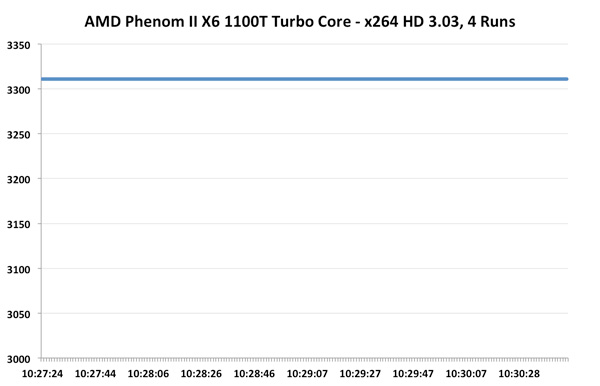
Unfortunately we see nothing of the sort. Turbo Core is pretty much non-functional on the Phenom II X6, at least running this workload. Average clock speed is a meager 3.31GHz, just barely above stock and likely only due to ASUS being aggressive with its clocking.
Now let's look at the FX-8150 with Turbo Core. The base clock here is 3.6GHz, max turbo is 4.2GHz and the intermediate turbo is 3.9GHz:
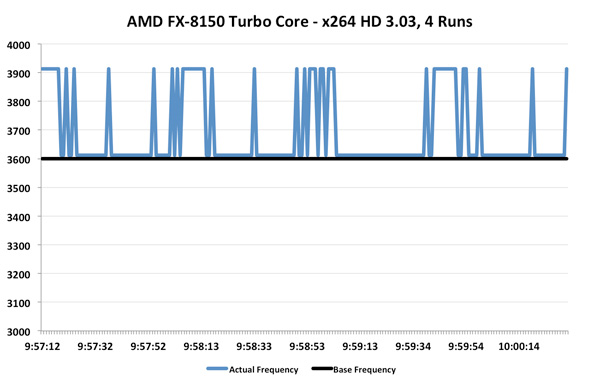
Ah that's more like it. While the average is only 3.69GHz (+2.5% over stock), we're actually seeing some movement here. This workload in particular is hard on any processor as you'll see from Intel's 2500K below:
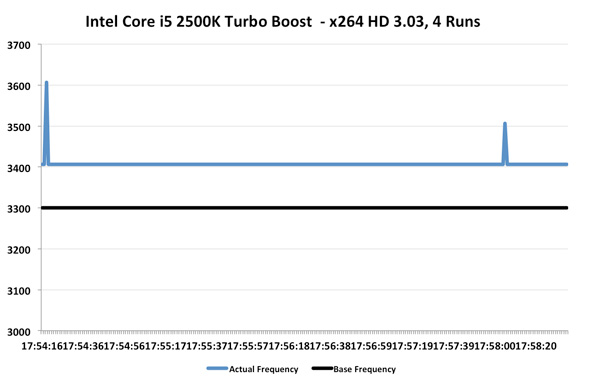
The 2500K runs at 3.3GHz by default, but thanks to turbo it averages 3.41GHz for the duration of this test. We even see a couple of jumps to 3.5 and 3.6GHz. Intel's turbo is a bit more consistent than AMD's, but average clock increase is quite similar at 3%.
Now let's look at the best case scenario for turbo: a heavy single threaded application. A single demanding application, even for a brief period of time, is really where these turbo modes can truly shine. Turbo helps launch applications quicker, make windows appear faster and make an easy time of churning through bursty workloads.
We turn to our usual favorite Cinebench 11.5, as it has an excellent single-threaded benchmark built in. Once again we start with the Phenom II X6 1100T:
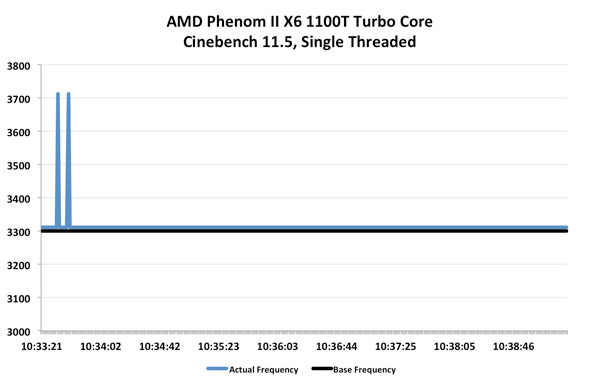
Turbo Core actually works on the Phenom II X6, albeit for a very short duration. We see a couple of blips up to 3.7GHz but the rest of the time the chip remains at 3.3GHz. Average clock speed is once again, 3.31GHz.
Bulldozer does far better:

Here we see blips up to 4.2GHz and pretty consistent performance at 3.9GHz, exactly what you'd expect. Average clock speed is 3.93GHz, a full 9% above the 3.6GHz base clock of the FX-8150.

Intel's turbo fluctuates much more frequently here, moving between 3.4GHz and 3.6GHz as it runs into TDP limits. The average clock speed remains at 3.5GHz, or a 6% increase over the base. For the first time ever, AMD actually does a better job at scaling frequency via turbo than Intel. While I would like to see more granular turbo options, it's clear that Turbo Core is a real feature in Bulldozer and not the half-hearted attempt we got with Phenom II X6. I measured the performance gains due to Turbo Core across a number of our benchmarks:

Average performance increased by just under 5% across our tests. It's nothing earth shattering, but it's a start. Don't forget how unassuming the first implementations of Turbo Boost were on Intel architectures. I do hope with future generations we may see even more significant gains from Turbo Core on Bulldozer derivatives.
Independent Clock Frequencies
When AMD introduced the original Phenom processor it promised more energy efficient execution by being able to clock each core independently. You could have a heavy workload running on Core 0 at 2.6GHz, while Core 3 ran a lighter thread at 1.6GHz. In practice, we felt Phenom's asynchronous clocking was a burden as the CPU/OS scheduler combination would sometimes take too long to ramp up a core to a higher frequency when needed. The result, at least back then, was that you'd get significantly lower performance in these workloads that shuffled threads from one core to the next. The problem was so bad that AMD abandoned asynchronous clocking altogether in Phenom II.
The feature is back in Bulldozer, and this time AMD believes it will be problem free. The first major change is with Windows 7, core parking should keep some threads from haphazardly dancing around all available cores. The second change is that Bulldozer can ramp frequencies up and down much quicker than the original Phenom ever could. Chalk that up to a side benefit of Turbo Core being a major part of the architecture this time around.
Asynchronous clocking in Bulldozer hasn't proven to be a burden in any of our tests thus far, however I'm reluctant to embrace it as an advantage just yet. At least not until we've had some more experience with the feature under our belts.


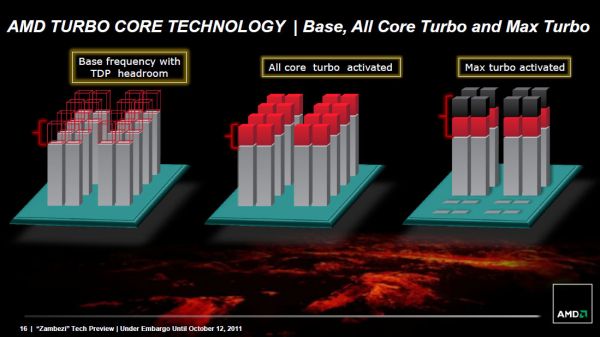








430 Comments
View All Comments
Iketh - Wednesday, October 12, 2011 - link
AMD Exec a year ago: "We about ready to release BD?"AMD Engineer: "Soon. At 4ghz, we're actually slower per thread and using double the power than Phenom at 3.4ghz, but we'll get there..."
AMD Exec: /gquit
lyeoh - Wednesday, October 12, 2011 - link
Bulldozer reminds me of the P4/Prescott for some reason ;).High clock, high watts, but not enough performance.
Might be faster in parallelizable tasks but most people with such tasks would just buy more computers and build large clusters.
Iketh - Wednesday, October 12, 2011 - link
The processors are popping up on Newegg now... the 8120 for $220 and 6100 for $190vol7ron - Wednesday, October 12, 2011 - link
Sigh... I made the mistake in buying a Prescott. Not to mention I bought an "E" batch, which ran even hotter and weren't as overclockable.actionjksn - Wednesday, October 12, 2011 - link
Yeah I had one of those hot potato's too. Back then we thought Intel was finished.just4U - Thursday, October 13, 2011 - link
ckryan, you stated you were blown away by the 2500K yes? It's odd you know.. I've owned a PII 920, PII 1055, PII 955 (tested lots of lowbie $60-80 parts from AMD to) .. also used a i7 920, i7 955 i5 2500k i7 2600k (my most recent one) and .. I am not blown away by any of them..Last time I was blown away by a cpu was the Q6600..(before that the A64 3200+) since then other cpu's have been better but not so much so that I'd say that it was night and day differences.
CeriseCogburn - Wednesday, March 21, 2012 - link
Ok that was some enormously skilled twisting and spinning. BD is an epic failure, period. I can't envision anyone with any needs, need, or combo thereof choosing it.\It's so bad amd lied about it's transistor count.
Forget it, it's an epic fail and never anything more.
jiffylube1024 - Wednesday, October 12, 2011 - link
Ugh, BD is quite the disappointment. The power consumption is absolutely through the roof -- unacceptable for 32nm, really!With that said, I am very intrigued in the FX-4100 4-core 3.6GHz part. This should be the replacement for the Athlon II 2-4 core series, and I'm very interested to see how it does vs ~3 GHz Athlon II X2's, X3's and X4's.
yankeeDDL - Wednesday, October 12, 2011 - link
Wow ...I'm blown away.
I have been waiting for BD's reviews and benchmarks for months. I have waited for BD for my new rig.
I have used AMD for the past 8 years and I am ... was convinced that it always offered, by far, the best price/performance ratio for entry-level, mid range PCs.
I am a still a big fan of AMD ... but I have to stand corrected. BD is a POS. Longer pipelines? Didn't they learn anything from Pentium 3/4 debacle?
A Phenom II X6 is almost always better than BD, even in power consumption. Come on: if BD had come out shortly after the Phenom I could see it as an incremental improvement, a new baseline to build upon. But it took AMD years to come out with BD ... and this is the result? Disappointing.
I mean, betting everything on higher clock frequencies? At 4GHz? It's no wonder that Intel's IPC improvements are crunching BD: IPC is all about doing more with the same power, clock speed is all about throwing more power to do the same faster ...
Boy. This ruined my day.
yankeeDDL - Wednesday, October 12, 2011 - link
By the way, no matter how AMD slices it, I see the FX-8* as a 4-core CPU. A glorified ohene, but still a 4-core.If I was AMD, I would have considered a fair goal to obliterate the i5-2500 performance with the new FX-8 family, instead it comes short most of the times.
What were they thinking?